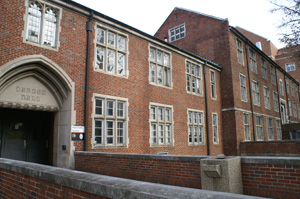
Charles W. Dabney Jr.
Charles W. Dabney Jr., proponent of New South scientific agriculture and respected president of the University of Tennessee from 1887 to 1899, was born in Hampden-Sydney, Virginia, to Robert Lewis and Lavinia Morrison Dabney. Dabney received his early education from his father and completed undergraduate study at Hampden-Sydney College. In 1873 he entered the University of Virginia, graduating in 1877 with a master’s degree in chemistry. He accepted a teaching position at Emory and Henry College in southwestern Virginia but left after one year, disillusioned with the demands of his teaching load and the failure of the college to support his stringent course requirements. In 1878 he enrolled at University of Gottingen in Germany, where he completed his studies in geology and chemistry under Friedrich Wohler, and received his doctorate in 1880.
Dabney returned to the University of North Carolina later that year and courted and wed Mary Brent of Paris, Kentucky. In 1881 he accepted a position as director of the North Carolina Experiment Station and was named official state chemist, a position that made him responsible for analyzing chemical fertilizers to combat fraud. Dabney joined the Watauga Club, an organization of southern reformers instrumental in establishing North Carolina’s first agricultural and mechanical college.
In 1887 Dabney’s rising reputation in agriculture and education produced an invitation from the University of Tennessee Board of Trustees to accept the position of university president and director of the agricultural experiment station. Dabney came to UT, but only after acquiring assurances that he would be permitted to administer the university without interference and that all departments would be responsible to him. The board of trustees reluctantly agreed.
At age thirty-two Dabney became the first Ph.D. to hold the presidency of the University of Tennessee. He joined the university at a pivotal moment in American higher education, as colleges and universities were moving from the goal of building character through classical education to an emphasis on research, science, and practical application. Dabney acted quickly to refocus the curriculum, requiring courses in agriculture and mechanics for all students, even though few accepted the challenge of making scientific agriculture their life’s work. During Dabney’s tenure UT added six new four-year courses in science and updated the physics curriculum. He added a home economics program, and by 1893 forty-eight women were enrolled. In 1890 he created a law department under the direction of former Tennessee Supreme Court Justice Thomas J. Freeman. Dabney’s interest in education extended to public schools, and he played a prominent role in the development of the programs of the Southern Education Board, a Rockefeller-financed organization that promoted support for public education. In 1901 Dabney hired Philander Claxton to plan and organize the Summer School of the South, a teacher-education program held annually on the Knoxville campus.
In 1894 Dabney took a leave of absence from the university (though he continued to hold the position of president) in order to accept an appointment by President Grover Cleveland as assistant secretary of agriculture. Many questioned the soundness of the arrangement, just as rural reformers had debated the efficacy and long-term consequences of yoking the agricultural experiment station to the university. Dabney returned to UT in late fall 1897. He continued to shape Tennessee’s higher education and agricultural institutions, moving education from the classics to science, and agriculture toward a reliance on university-directed programs of farm management conducive to modern agribusiness.
In 1904 he accepted the presidency of the University of Cincinnati. Dabney died in 1945.



